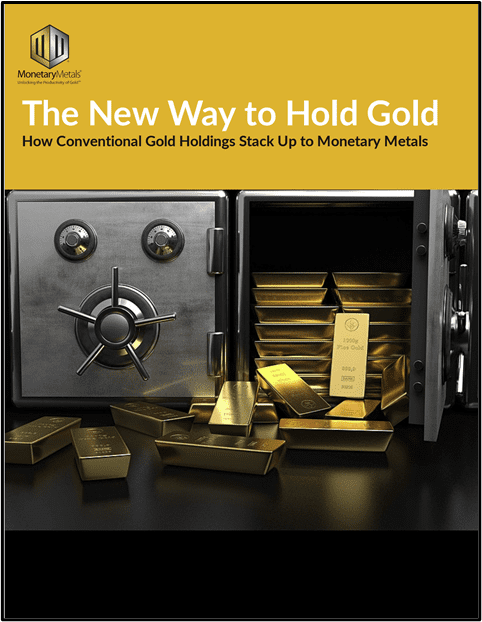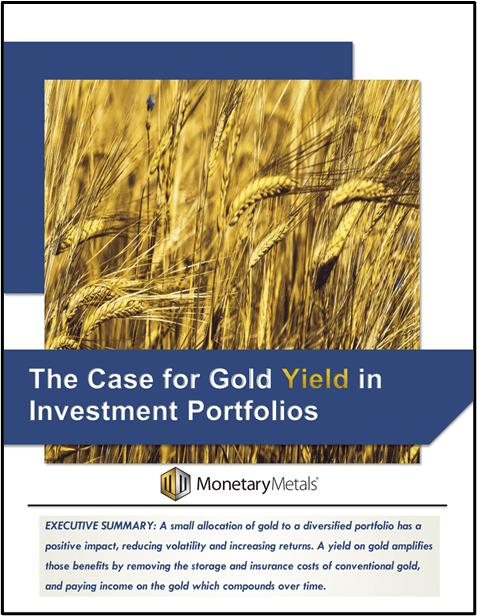How Can the State Bank of India Pay Interest in Gold?
An article caught my eye this week. The Tirumala Tirupati Temple in India has deposited gold at the State Bank of India, and is getting paid interest on their deposit. There is something unique about this. The interest is paid in gold.
To understand why no one else is paying interest in gold, let’s first look at how one can use any asset class to make a dollar income: speculation. Buy something. Wait. Sell it at a higher price. You can use bonds, stocks, real estate, artwork, or classic Ferraris. By the way, no matter what you use, you are converting what had been someone else’s capital into your own income. This is capital destruction on a massive scale.
Using gold to produce a dollar income is simple. Just sell a covered call with a strike price a little higher than the current market price. You get paid a premium immediately. If the gold price does not rise, then you can repeat the trick and sell another call. If it does rise, you must sell the gold at the strike price. This earns you a profit, as it is above what you paid. Then just buy more gold and do it again.
If you keep your books in dollars, and trade for dollar gains, you don’t really care how much gold you have. You only care about how many dollars. If the gold price doubles, you may end up with about half the gold. But who cares, at least you’re making a steady stream of dollars that you can consume.
Making a gold income is something else.
You can’t just sell calls, or sell the gold itself. If you do, and the gold price rises, you will have to buy the gold back. However, the same dollars you have will get you less gold at the higher price. For example, you start with 100oz gold. Today the price is about $1,300 per ounce, and you sell a December call option. It has a strike price of $1,325 and you get paid immediately $25 per ounce or $2,500 for the contract.
Unfortunately—yes this is unfortunate as we shall see in a moment—the gold price jumps in September. It goes to $1,500 and holds steady there. In December, you deliver the gold and per your contract you are paid $1,325 per ounce. Now you have $1,325 × 100oz = $132,500 + the option premium of $2,500 = $135,000.
When you go to buy your gold back, you discover the catch. At the new price, you can only get $135,000 ÷ $1,500 = 90oz. Even after picking up almost two ounces worth of pennies in front of the steamroller, it still squeezed 10 ounces out of you. Your 100oz shrunk to 90oz.
Would you like to play again?
This is why the headline in the International Business Times caught my eye. The bank is paying 1% on the temple’s gold, in gold! It may not sound like a lot, but that means for every 100oz the temple deposits, it gets back 101oz next year. It does not face the risk of having its gold called away at the next crisis flare-up.
I wondered how the bank could pay this interest in gold. After all, if you can’t make a yield on your gold and the temple can’t make a yield on its gold, how can the State Bank of India make a yield on gold?
I asked some of my friends from India this question. I got two basic answers. One way they could do this is by selling the gold and investing the proceeds in a dollar denominated instrument that pays interest. The bank makes, say 4%, and pays the temple 1%. It sounds feasible, but there is a very basic catch. As we saw above, if the gold price rises, there is a loss in gold.
The temple’s account is denominated in gold. If the books are kept using gold as the unit of account—as they should be—then the dollars must be marked to market. This is a profoundly important but subtle point.
On gold books, if you hold gold, then there are no profits or losses. Only when you buy an asset such as the dollar (i.e. sell gold), do you start marking gains and losses on your books, whenever the dollar price changes.
Going back to our example, you begin with 100oz of gold. You buy 130,000USD, at the price of 23.93mg (a dollar price of 23.93mg gold is equivalent to a gold price of $1,300 per ounce). Now you have 100oz worth of dollars (it’s awkward, at first, to say that, but it’s perfectly valid).
Then the dollar price falls 13.3% to 20.74mg (i.e. the gold price rises to $1,500). You still own 130,000USD. Now it’s worth only 86.68oz. You have lost 13.32oz. This is bad enough for the investor, but it’s a much more serious problem for a bank.
A bank balance sheet has assets matched to liabilities. The liability is the gold deposit owed to the depositor, in this case 100oz. The asset is whatever the bank bought, in this case 130,000USD. Now, this sum of USD is only worth about 86oz. The bank has a very big problem. If this happened in enough accounts, it would be bankrupt.
I am not satisfied with the first answer. Several people told me that it’s just the risk the bank takes to do business. I disagree.
Lending money incurs risk. You hope the borrower will repay it. You do all of your diligence to verify that the borrower has the means and intent to repay. There is a chance that, despite this, he defaults. An analogy is that you have car insurance because no matter how carefully you drive, you may crash.
The falling dollar price is not a mere “risk”. It is a certainty. Just look at a graph over the past 100 years. In the analogy of driving a car, this is like driving over the cliff edge into the Grand Canyon. A collision is certain.
The second answer I got was less complicated and more sinister. The bank could be planning fraud, and not intending to ever repay the gold. They might get the government to declare that all gold deposits are redenominated in paper money.
I don’t know which of these two answers is correct. I hope they are both wrong, and there is something real backing their gold deposits. If you know something about this, I would love to hear from you.
The gold interest rate is a very important topic. The world is not yet prepared to grasp it. However, with each insolvency, quantitative easing, falling currency, bail-in, and the inevitable rise of the gold price, the tide is turning.
Make sure to subscribe to our YouTube Channel to check out all our Media Appearances, Podcast Episodes and more!
Additional Resources for How to Earn Interest on Gold
If you’d like to learn more about how to earn interest on gold with Monetary Metals, check out the following resources:
In this paper we look at how conventional gold holdings stack up to Monetary Metals Investments, which offer a Yield on Gold, Paid in Gold®. We compare retail coins, vault storage, the popular ETF – GLD, and mining stocks against Monetary Metals’ True Gold Leases.
The Case for Gold Yield in Investment Portfolios
Adding gold to a diversified portfolio of assets reduces volatility and increases returns. But how much and what about the ongoing costs? What changes when gold pays a yield? This paper answers those questions using data going back to 1972.







Keith
Seems unrealistic; lease rate .35 % ..allows for a free profit of .65%/year in au.
I think they pay the 1% interest in gold (plated tungsten)
Seems to me little different than buying paper gold. If you don’t hold physical, you don’t have anything except a paper promise.
The only way I can think of offhand that this isn’t A) a bank possibly going bankrupt or B) sinister, is that the bank backs the gold with something else that’s real, i.e., land, such that if the price of gold (in dollars) rises higher than the interest the bank receives in investing the proceeds, the land is sold to make good the debt in gold.
And you believe that, I have some gold paper contracts I’ll be happy to sell you at a 10 percent discount to physical market prices. :)
Keith–I think the answer is that like all Central Banks or other government run banks, they plan to privatize the gains and socialize the losses.
The classic answer is simple: if the gold was used to finance (say, as collateral) a productive investment yielding over 1%, everybody wins. The Temple gets its 1% and the State Bank gets anything over that. Conversion into currency need not be part of the equation.
Being India, however, I suspect some sort of favor is going on.
I think Sanctuary’s formula is about right. Whichever way the bank’s fortune cuts, the fact that the gold deposit is dedicated to a sacred cause covers them in any debate that may follow.
But, at the risk of destroying some of the capital in your fine article, I can pile-on another speculation:
The State Bank and the State’s tariff and import authorities could be in bed: plotting to de-stabilize the internal gold price and use their inside timing-information to shake down India’s gold traders.
The fact that the promised return is so far above the usual lease rates suggests that the Temple understands and condones the plot – is not a victim. Just another guess.
Let us know what you learn, Keith.
I think the problem here is that we are equating dollars to gold. It is true that dollars can buy gold and gold can buy dollars but they are not the same. If the Temple loans gold and receives goad then the only risk is the default on the loan. The dollars are just background noise. A dollar after all, is just a debt. Gold is an asset. This is something like comparing apples and oranges.
Another way to loan gold is to require repayment in oil. These are totally different assets, however. The benefit is that they both have actual value. The mechanics of this loan would be less complicated if dollars were ignored altogether.
Holding dollars is like storing your water in a leaky bucket. [As Keith wrote, just look at the graph of the dollar over the last hundred years.] When you come back later examine the contents of your bucket, you notice that some of the water is gone from leaks and evaporation. How do you compare two assets when one of those assets is a moving target?
My conclusion is, that loaning gold for gold make sense if you ignore the dollar and require repayment and the interest in gold. With this in mind can set an interest rate of f5, 10 or even 12%, etc.
Another way to look at this is that it makes no more sense to loan gold and accept payment in dollars, than it does to loan gold and accept payment in stocks of TSLA. Tesla is an even faster moving target than dollars because it fluctuates so much up and down.
From The China Gold Market Report 2008:
Gold leasing business, also called ”lending gold and paying back in gold” business, is a service where commercial banks lend their gold holdings to other commercial banks or gold producers or manufacturers and charge interests as the leasing contract stipulates. The gold borrowers shall pay back the liability with physical gold when the contract expires. This business can be divided into inter-bank lending and corporate leasing classified by the leasing targets.
Inter-bank lending means short-term gold leasing between commercial banks, where the borrower sells the leased gold on the market or use it to produce its proprietary brand of physical gold bars, and then purchases gold through the market to repay the lender upon expiry of the contract. Corporate leasing means that the gold producer sells the leased gold on the market for capital and pays gold produced by itself back to the commercial bank, or uses the leased gold in jewelry processing or other purposes and then purchases gold through the market using the sales income of jewelry to repay the lender upon expiry of the contract.
Thanks for the great comments. Here is a quick thought:
mongoose: There was always a choice to hoard one’s gold, earning nothing, or take the risk and lend it out to get a yield. JP Morgan once said something to the extent of “4% will bring the gold from the Continent [i.e. to NY], 5% will pull the gold off the moon.”
The alternative, if no one lends, is total collapse of the economy.
Keith, where is that quote from ?
Dear Keith,
The correct answer is that SBI lend the gold to the Indian Jewellers @ 4-5% interest and the interest is paid in terms of Gold itself. There is complete hedging and no need to go for exotic structuring. The timing of its giving back the Gold to the temple and receiving the gold given to the jeweller is same. In effect there is no future price riskl. In toto, they generate good 3-4% NIM in this scheme.
Cheers,
Yess this can be a win win situation for all and at the same time cad issues are taken care off. Which is the need of the hour in indian economy terms
Hi Keith. This is quite a profound article you’ve written. I’ve normally thought about the holders of gold generating an income using a different mechanism (selling spot, buying a future on margin, and investing the cash difference). In the end the conclusions are the same. This only works if the dollar price of gold is stable or falling. If the price rises, which eventually it must, then capital is destroyed. If correct then this implies that compared to gold, owning debt is ALWAYS a speculation.
Hi Keith,Couple of points -But before that, since this is India some serious 3rd party benefit, quid pro pro could be in place.
Firstly ,couple of years ago read a news item about Belgian Govt gold deposits moved to a 3rd part account and the Govt had received an interest on it of 0.50 % per annum. Obviously this led to a din in the country. Could you please throw some more light on this
Secondly, if the gold deposit is still in any of their Indian branch, SBI though paying in gold but the denomination for converting purpose would be in Rupee I presume.
Thirdly-Ignoring all proprietory/legal issues –Assuming deposits are being maintained in Indian branches.SBI bank issues credit limit ( against the gold deposit of the Trust)in favour of some high powerd cients with the knowledge or otherwise of the Trust..Bank will easily earn 10-12 % per annum ( in rupees)for any loan advanced against these limits..Given the decay in gold prices and a mostly depressed Rupee ( against any major currency) in the past one year many who have taken small gold loans in India ( small traders /small business men /households )would be hard pressed to service their margin calls/ loans in lieu of falling prices and in addition to any distress that they may have suffered in their small business and have probably turned NPA..This is where SBI gets atleast some of the gold to pay the 1% interest ( albeit partly).For the balance part given the fall in prices it would be smart to buy the gold for interest payment from the market.
My third point is certainly speculative and could have many flaws but what is your opinion in the light of making commercial sense of this arrangement in lieu of future gold prices, Rupee fluctuations etc?—your kind comments please.